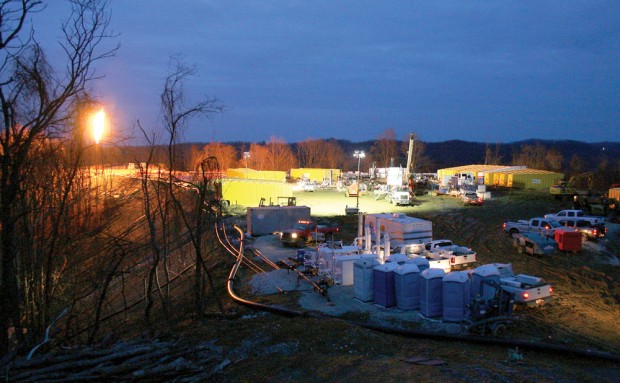A plume of methane flares at a natural gas hydrofracturing site in Wetzel County, W.Va. Photo: Ray Renaud
Rose Baker can no longer drink the water from her well. About four years ago, natural gas drilling companies came into Wetzel County, a rural area in West Virginia near its border with Pennsylvania. Now, Baker and her neighbors have to keep their taps turned off, as their wells are full of methane and a long list of hazardous chemicals.
“We didn’t have a problem until they started drilling here,” Baker says.
Natural gas development has increased exponentially in the past decade in the United States, fueled, in part, by the search for a cleaner-burning domestic fuel source. But does the environmental harm inflicted by extracting the gas outweigh its benefits?
Wetzel County sits atop the second largest natural gas deposit in the world. The Marcellus Shale stretches from New York through Pennsylvania and West Virginia and into parts of Maryland, Ohio and Virginia. Contained within this formation could be as much as 516 trillion cubic feet of gas — enough to meet the country’s needs for roughly twenty0 years based on current usage levels (however, only 50 trillion cubic feet, or two years worth, is recoverable using current drilling techniques).
Until recently, shale gas, which is contained in small pockets within this rock thousands of feet beneath earth’s surface, had been too costly to tap. Technological advances in a process called hydraulic fracturing — hydrofracking, for short — have changed that. The process involves pumping millions of gallons of water, sand, and chemicals at extremely high pressure into a well to cause cracks in the rock so the trapped gas can escape. Of the 750 different chemicals used in fracking fluid, 29 are known or possible carcinogens. Most of the others have not been tested or researched for their toxicity.
In November 2008, Baker’s neighbor and sister-in-law, Bonnie Hall, noticed her water had turned gray and started to smell bad after a second gas well was drilled near her home. A water test came back positive for methane and the toxic chemicals benzene and toluene. Chesapeake Energy and the West Virginia Department of Environmental Protection both said the cause was spilled gasoline from her neighbor’s property — a mile away. Hall blames the pollution on the gas well being drilled through her aquifer.
“That’s kind of scary, because that’s our drinking water supply they’re going through to get to this natural gas,” Hall says.
The gas industry disputes the claims of Baker, Hall, and others.
“We have multiple layers of steel casing and cement that, if done properly, ensure that the hydrocarbons and fracturing fluids cannot, in any way, shape or form, communicate with freshwater aquifers,” says Travis Windle, a spokesman for the Marcellus Shale Coalition, a natural gas industry group.








